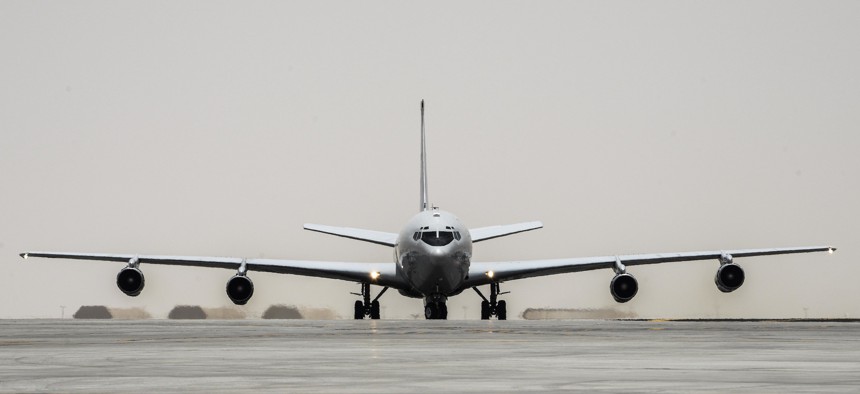
An E-8C Joint Surveillance Target Attack Radar System taxis down the runway after completing a mission June 7, 2016, at Al Udeid Air Base, Qatar. U.S. Air Force / Senior Airman Janelle Patiño
Above Ukraine, a Cold War Spy Plane Is Finally Tracking a Russian Invasion
Air Force officials had already started retiring 30-year-old E-8C JSTARS.
Three decades after its first mission, one of the most capable American spy planes is finally doing the job it was built for: tracking Russian forces as they invade eastern Europe.
The E-8C Joint Surveillance Target Attack Radar System, or JSTARS, has spent its career flying missions from Desert Storm to the wars in Iraq and Afghanistan. But in recent months, the plane has flown near the Russian border.
“It was designed in response to the Soviet threat in Eastern Europe, almost exactly what's happening right now,” an Air Force official said.
The unarmed, heavily modified Boeing 707 uses its belly-mounted radar to watch a nearly 20,000-square-mile area. Its crew of Air Force and Army battle managers analyze and process the radar pictures, which are then sent to commanders.
The E-8C, along with RC-135 Rivet Joint, RQ-4 Global Hawk drone, and others have been seen by aircraft spotters over and around Ukraine.
In most cases, these planes squawk their locations, meaning they emit an electronic safety-and-transparency signal that can be detected and tracked by nearby aircraft, ground controllers, and public flight-tracking databases. A former Air Force official said these beacons don’t put these large, non-stealthy aircraft at any greater risk of being shot down because they already show up clearly on Russian military radar. The signal also helps keep the plane from being misidentified.
Pentagon officials first came up with the idea for a JSTARS plane in the 1970s, but it wasn’t until the early 1980s when the Air Force and Army created a joint program. Instead of buying a plane new from the factory, used Boeing 707 airliners were converted into E-8Cs.
“It was basically designed to give the [Army] brigade-level commander real-time information of what [tank] columns were doing, to keep him from getting out-flanked,” the Air Force official said.
Earlier this month, the Air Force retired the first E-8C, one of four planes Congress gave the service permission to retire this year, which will leave one dozen still flying. Air Force officials want to replace the E-8C with the Advanced Battle Management System, a network of satellites and other tracking sensors.




